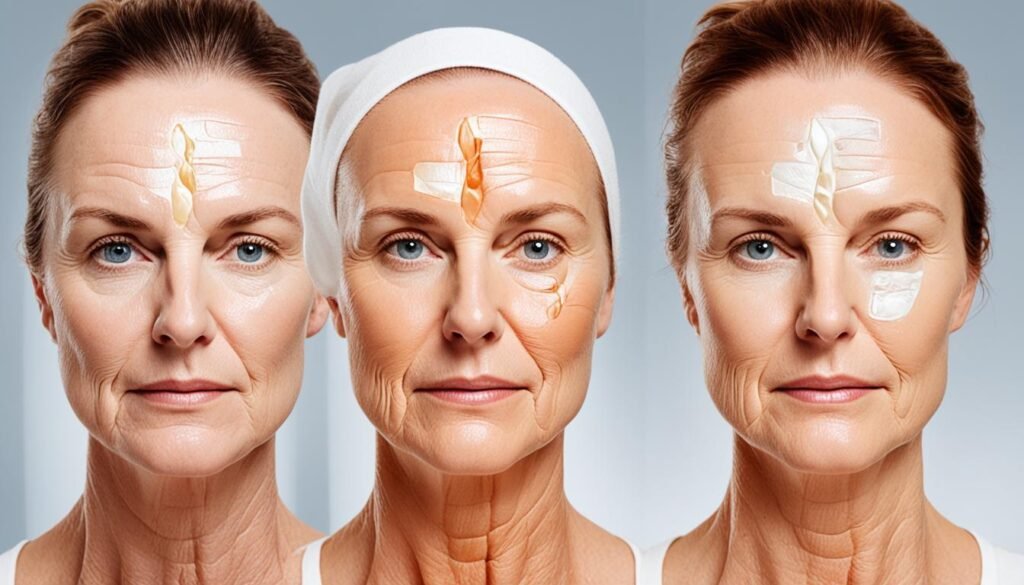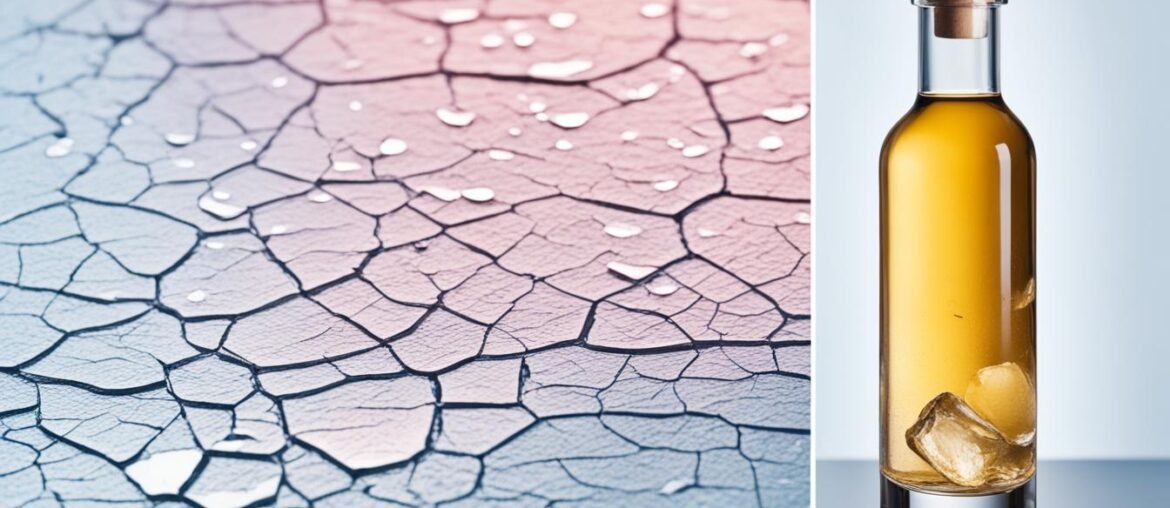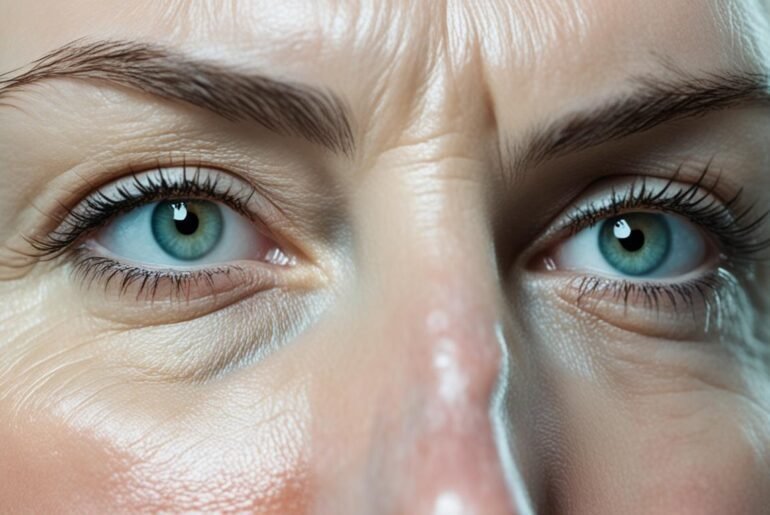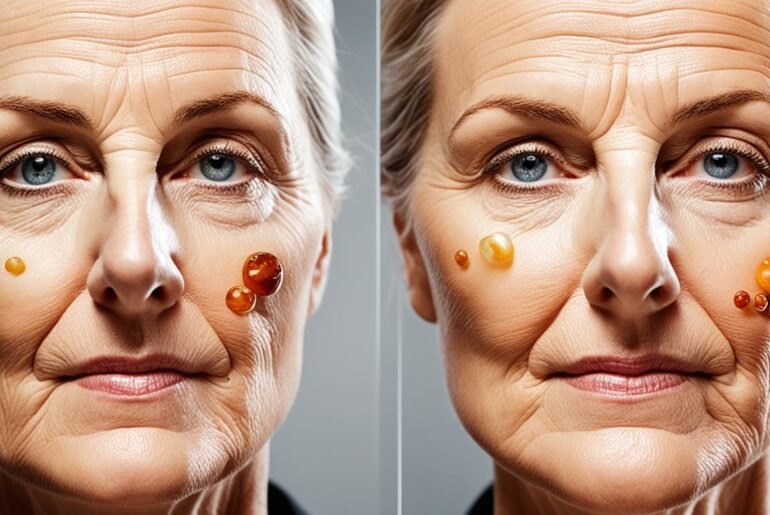Did you know that alcohol can have significant effects on the hydration levels of your skin? Alcohol consumption, especially prolonged and excessive, can lead to various skin problems such as dryness, reduced elasticity, and flushing. Not only does alcohol act as a diuretic, causing the body to lose water and salt, but it can also disrupt sleep patterns, worsen underlying skin conditions, and increase the risk of developing more serious skin issues.
Key Takeaways:
- Alcohol acts as a diuretic, causing dehydration and leading to dry skin, sunken eyes, and decreased elasticity.
- Alcohol-induced flushing can result in a flushed or inflamed complexion.
- Disrupted sleep from alcohol consumption can cause darker circles under the eyes and a dull complexion.
- Prolonged and heavy alcohol consumption increases the risk of skin infections, skin cancer, and skin changes associated with alcoholic liver disease.
- Alcohol can worsen specific skin conditions such as rosacea, psoriasis, seborrheic dermatitis, porphyria cutanea tarda, and discoid eczema.
Dehydration and Skin Effects
Alcohol consumption can have significant effects on the hydration levels of the skin. Due to its diuretic properties, alcohol causes the body to produce and release more urine, resulting in increased water and salt loss. This dehydration can lead to various skin problems, including:
- Dryness
- Sunken eyes
- Decreased elasticity
- Dry lips
Dehydration also weakens the immune system, making the skin more prone to infections. To prevent dehydration and mitigate its impact on the skin’s moisture levels, it is crucial to stay hydrated while consuming alcohol. Drinking water between alcoholic drinks helps replenish the lost fluids and maintain the skin’s natural moisture balance.
Take a look at the table below for a summary of the effects of alcohol-induced dehydration on the skin:
| Effects of Dehydration on Skin | Preventing Dehydration from Alcohol Consumption |
|---|---|
| Dryness | Stay hydrated by drinking water between alcoholic beverages |
| Sunken eyes | Mitigate dehydration’s impact on the skin’s moisture levels |
| Decreased elasticity | Replenish lost fluids to maintain the skin’s natural moisture balance |
| Dry lips | Be mindful of your alcohol consumption to prevent dehydration |
Dehydration can have long-term consequences on the overall health and appearance of the skin. Maintaining proper hydration is key to ensuring a healthy and radiant complexion.
Flushing and Skin Inflammation

Alcohol consumption can have various effects on the skin, one of which is facial flushing. This occurs when histamines are released, causing the blood vessels under the skin to dilate. The result is a flushed or inflamed complexion. While facial flushing may initially seem like a minor concern, prolonged and excessive alcohol consumption can lead to persistent facial redness that becomes difficult to alleviate.
It is important to note that individuals of East Asian descent may be particularly susceptible to alcohol-induced flushing. This is due to a deficiency in an enzyme involved in alcohol processing. Therefore, their bodies may have a heightened response to alcohol, resulting in more pronounced flushing.
To better understand the effects of alcohol-induced flushing, let’s take a closer look at the underlying mechanisms:
- When alcohol enters the body, it stimulates the release of histamines.
- Histamines cause blood vessels to expand, resulting in increased blood flow to the skin.
- This increased blood flow gives the skin a flushed or reddened appearance.
To illustrate the impact of alcohol on complexion, let’s consider a case study:
A 35-year-old individual regularly consumes alcohol in moderate amounts. Over time, they notice that their face becomes increasingly flushed, even after minimal alcohol consumption. Despite attempts to reduce alcohol intake, the persistent redness remains a cause for concern.
As seen in this case, alcohol-induced flushing can have a significant impact on an individual’s complexion, causing persistent redness and potentially affecting self-confidence.
| Effects of Alcohol-Induced Flushing | Impact on Complexion |
|---|---|
| Facial redness | Red or flushed appearance |
| Persistent flushing | Difficult to alleviate |
| Increased sensitivity | Tendency to blush easily |
Table: Effects of Alcohol-Induced Flushing on Complexion
Sleep Disruption and Skin Changes
Alcohol consumption can have a significant impact on sleep quality, leading to disrupted sleep patterns that can affect the skin’s appearance. When we don’t get enough quality sleep, it can show on our faces. The effects of disrupted sleep on the complexion can include darker circles under the eyes, paler skin, a duller complexion, and increased wrinkles or fine lines. Regular alcohol consumption can exacerbate these effects, making them more severe and long-lasting.
During sleep, our body repairs and rejuvenates itself, including the skin. Disrupted sleep can interfere with this natural restorative process, preventing the skin from properly recovering and regenerating. Lack of quality sleep can also increase the release of the stress hormone cortisol, which can contribute to inflammation and premature aging of the skin.
Furthermore, alcohol’s impact on sleep goes beyond simply disrupting the quantity of sleep. It can also affect the quality of sleep, making it harder for us to enter into deep, restorative sleep stages. This can result in feeling tired and groggy upon waking, as well as an overall lack of restfulness that can take a toll on the complexion.
To visualize the effects of sleep disruption on the skin, take a look at the following table:
| Sleep Disruption Effects on Skin | Description |
|---|---|
| Darker circles under the eyes | Visible discoloration and puffiness around the eye area |
| Paler skin | Loss of natural skin color and vibrancy |
| Duller complexion | A lackluster appearance with reduced radiance |
| Increased wrinkles or fine lines | Prominent lines and creases, especially around the eyes and mouth |
Image:
In conclusion, disrupted sleep caused by alcohol consumption can have a negative impact on the skin’s appearance. To maintain a healthy complexion, it is important to prioritize good sleep hygiene and limit alcohol intake to ensure restful and restorative sleep.
Long-Term Effects on Skin

Prolonged and heavy alcohol consumption can have detrimental effects on the health of your skin. The long-term consequences of heavy drinking can increase the risk of developing various skin conditions and impair the skin’s natural defense mechanisms.
One of the significant risks associated with heavy drinking is the weakening of the immune system, making individuals more susceptible to bacterial and fungal skin infections. Alcohol weakens the body’s ability to fight off diseases, leaving the skin vulnerable to infections that can lead to inflammation and discomfort.
Furthermore, alcohol’s impact on the skin extends to its vulnerability to the harmful effects of ultraviolet (UV) light. Excessive alcohol consumption weakens the skin’s natural protection against UV radiation, increasing the risk of sunburn, skin damage, and potentially skin cancer.
Another concerning long-term effect of heavy drinking is alcoholic liver disease, which can manifest in various changes to the skin. These changes include jaundice (yellowing of the skin and eyes), darkened skin around the eyes, visible blood vessels on the face, neck, and chest, and itchy skin.
It is crucial to be aware of the potential long-term consequences of heavy alcohol consumption on skin health. Taking steps to mitigate these risks, such as reducing alcohol intake and seeking treatment for alcohol addiction, can help safeguard the health and appearance of your skin.
Alcohol and Specific Skin Conditions
Alcohol consumption can have detrimental effects on various skin conditions, including rosacea, psoriasis, seborrheic dermatitis, porphyria cutanea tarda, and discoid eczema. Let’s explore the impact of alcohol on these specific skin conditions and the importance of addressing alcohol consumption in their treatment.
Alcohol’s Impact on Rosacea
People with rosacea may experience worsened symptoms due to alcohol consumption. Alcohol-induced flushing can cause persistent redness, flushing, and inflammation, making rosacea more difficult to manage and control.
Alcohol’s Effect on Psoriasis
Heavy alcohol consumption can increase the risk of developing psoriasis or aggravate existing psoriasis symptoms. Moreover, alcohol can make psoriasis more resistant to medical treatments, making it crucial to address alcohol consumption when managing this chronic condition.
Alcohol’s Impact on Seborrheic Dermatitis
Seborrheic dermatitis, a common skin condition characterized by red, itchy, and flaky patches, may be more prevalent in heavy drinkers. Reducing alcohol consumption can help manage seborrheic dermatitis and alleviate its symptoms.
Alcohol as a Cause of Porphyria Cutanea Tarda
Porphyria cutanea tarda (PCT), a rare skin disorder, is often caused by alcohol consumption. PCT leads to blistering and increased sensitivity to sunlight. Limiting alcohol intake is crucial in managing this condition and preventing further skin damage.
Discoid Eczema and Alcohol
Discoid eczema, also known as nummular dermatitis, is more commonly seen in individuals who misuse alcohol, especially those with existing liver problems. Proper treatment for discoid eczema requires addressing both the skin condition and alcohol consumption.
When treating these specific skin conditions, it is essential to consider the impact of alcohol consumption. Limiting or abstaining from alcohol can significantly improve the management and outcomes of these conditions. Seeking medical advice and exploring appropriate treatment options tailored to individual needs are vital for optimal skincare and overall well-being.
Tips to Mitigate Alcohol’s Effects on Skin

When it comes to alcohol’s impact on the skin, taking proactive measures can help reduce its negative effects. Here are some tips to help mitigate the effects of alcohol on your skin:
- Stay hydrated: One of the main culprits behind alcohol’s negative effects on the skin is dehydration. Alcohol acts as a diuretic, causing the body to lose water and essential moisture. To counteract this, drink water between alcoholic beverages to stay hydrated.
- Apply topical brimonidine: If you have rosacea and are prone to flushing after consuming alcohol, applying topical brimonidine before drinking can help minimize the appearance of flushing. This medication works by constricting blood vessels in the skin, reducing redness and inflammation.
- Avoid excessive alcohol consumption: For individuals dealing with skin conditions related to alcohol addiction, alcohol-related liver disease, or excessive alcohol consumption, the best course of action is to stop drinking alcohol altogether. Cutting back on alcohol consumption can significantly improve your skin’s health and appearance.
- Seek professional guidance: If you’re struggling with alcohol addiction or have skin problems related to alcohol consumption, don’t hesitate to seek help from healthcare professionals. They can provide guidance, support, and effective treatment options catered to your specific needs.
By following these tips and taking proactive steps to mitigate alcohol’s effects on your skin, you can maintain healthier and more vibrant skin, even while enjoying the occasional drink.
Stay hydrated and take necessary steps to minimize alcohol’s impact on your skin. Seek professional guidance if needed to address any alcohol-related concerns. Your skin will thank you for it.
Treatment Options for Alcohol-Related Skin Issues
Treating skin problems caused by alcohol consumption involves a two-fold approach. Firstly, addressing the alcohol use disorder (AUD) or alcohol addiction is crucial. Various treatment options can help individuals overcome their alcohol misuse and regain control over their lives.
- Cognitive-Behavioral Therapy (CBT): CBT is a widely used therapeutic intervention that helps individuals identify and modify unhealthy behaviors, thoughts, and emotions related to alcohol addiction. It aims to develop coping strategies, enhance self-control, and prevent relapse.
- Detoxification: Medically supervised detoxification is necessary for individuals with severe alcohol dependence to manage withdrawal symptoms safely. This process involves the elimination of alcohol toxins from the body while ensuring the patient’s safety and comfort.
- Inpatient or Outpatient Rehabilitation: Inpatient rehabilitation programs provide intensive treatment and a supportive environment to individuals struggling with alcohol addiction. Outpatient programs, on the other hand, offer flexibility while providing counseling, therapy, and support groups.
- Peer Support Groups: Joining support groups such as Alcoholics Anonymous (AA) or SMART Recovery can provide individuals with a sense of community, encouragement, and shared experiences. These groups often follow a 12-step program to support individuals in their recovery journey.
- Medications: Certain medications can aid in alcohol addiction treatment by reducing cravings, managing withdrawal symptoms, or blocking the pleasurable effects of alcohol. Medications should be prescribed and monitored by healthcare professionals.
Secondly, addressing any underlying skin conditions that remain after stopping alcohol consumption is essential to achieving optimal skin health. Coexisting skin issues may require specific medical treatments:
| Skin Condition | Treatment Options |
|---|---|
| Alcoholic Liver Disease | Medical management to address liver damage, lifestyle changes, and possibly liver transplant |
| Psoriasis | Topical corticosteroids, immunosuppressive drugs, phototherapy, and systemic medications |
| Rosacea | Topical and oral antibiotics, laser therapy, and lifestyle modifications |
| Seborrheic Dermatitis | Antifungal creams, medicated shampoos, topical corticosteroids, and lifestyle changes |
| Porphyria Cutanea Tarda | Treatment aimed at managing underlying liver disease, avoiding triggers, and sun protection |
| Discoid Eczema | Emollients, topical corticosteroids, and lifestyle modifications to minimize triggers and promote healing |
It is crucial to consult a healthcare professional to determine the most appropriate treatment options for these skin conditions. Individualized care plans can help manage symptoms, prevent flare-ups, and support overall skin health on the journey to recovery from alcohol-related skin issues.
Seeking Support for Alcohol-Related Concerns
If you’re concerned about your alcohol consumption or finding it challenging to manage your intake, seeking support is crucial. There are various resources available to help you on your journey towards recovery. One option is to consult a healthcare professional who can provide guidance and support tailored to your specific needs.
Another valuable source of support is reaching out to trusted friends and family members. They can offer emotional support and assist you in finding solutions to address your alcohol-related concerns. Additionally, community support groups and online forums dedicated to alcohol addiction recovery can be invaluable in connecting you with others who are facing similar challenges.
Utilizing technology can also be helpful on your path to recovery. There are numerous apps available that allow you to track your alcohol consumption, set goals, and receive support for quitting. These digital tools can provide a sense of accountability and motivation as you work towards reducing or quitting alcohol.
Remember, you don’t have to face your alcohol-related concerns alone. There are resources and support systems in place to assist you. Taking the first step towards seeking help is a positive decision that can have a profound impact on your overall health and well-being, including the health of your skin.
FAQ
How does alcohol affect skin hydration?
Alcohol can have significant effects on the hydration levels of the skin. Prolonged and excessive alcohol consumption can lead to various skin problems such as dryness, reduced elasticity, and flushing.
What are the effects of alcohol on the skin’s moisture balance?
Alcohol acts as a diuretic, causing the body to lose water and salt, which can result in dry skin, sunken eyes, decreased elasticity, and dry lips. It can also worsen underlying skin conditions.
Can alcohol cause flushing of the skin?
Yes, alcohol consumption can cause facial flushing by dilating blood vessels under the skin. This can result in a flushed or inflamed complexion, especially in individuals of East Asian descent who may have a deficient enzyme for alcohol processing.
How does alcohol disrupt sleep patterns and affect the skin’s appearance?
Alcohol can disrupt sleep patterns, leading to changes in the skin’s appearance, including darker circles under the eyes, paler skin, a dull complexion, and more wrinkles or fine lines.
What are the long-term effects of alcohol on the skin?
Heavy and prolonged alcohol consumption can increase the risk of developing skin infections, skin cancer, and skin changes associated with alcoholic liver disease. It can also worsen underlying skin conditions.
Can alcohol worsen specific skin conditions?
Yes, alcohol consumption can worsen specific skin conditions such as rosacea, psoriasis, seborrheic dermatitis, porphyria cutanea tarda, and discoid eczema.
Are there any tips to mitigate the effects of alcohol on the skin?
Staying hydrated by drinking water between alcoholic drinks and limiting alcohol intake to recommended guidelines can help mitigate the negative impact on skin hydration. Applying topical brimonidine before drinking alcohol can also reduce the appearance of flushing, especially for individuals with rosacea.
Treating skin issues related to alcohol consumption involves addressing the alcohol use disorder or alcohol addiction and seeking specific medical treatments for any underlying skin conditions remaining after stopping alcohol consumption.
Individuals who are concerned about their alcohol consumption or struggle with managing their intake can seek support from healthcare professionals, friends, family members, support groups, and online resources dedicated to alcohol addiction recovery.




